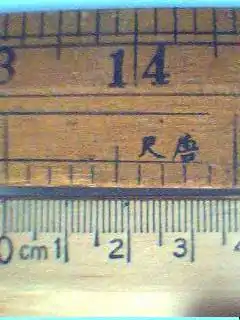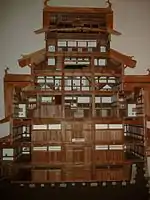| Cun | |||||||||||
|---|---|---|---|---|---|---|---|---|---|---|---|
| Chinese name | |||||||||||
| Chinese | 寸 | ||||||||||
| |||||||||||
| Japanese name | |||||||||||
| Kanji | 寸 | ||||||||||
| Kana | すん | ||||||||||
| |||||||||||
| Korean name | |||||||||||
| Hangul | 치 | ||||||||||
| Hanja | n/a | ||||||||||
| |||||||||||
| Alternative Korean name | |||||||||||
| Hangul | 촌 | ||||||||||
| Hanja | 寸 | ||||||||||
| |||||||||||
| Vietnamese name | |||||||||||
| Vietnamese | thốn | ||||||||||
| Cun | |
|---|---|
 Wooden ruler of the western Han dynasty, unearthed at Jinguan Pass Site in Jinta County | |
| General information | |
| Unit system | Chinese unit |
| Unit of | length |
| Conversions | |
| 1 cun in ... | ... is equal to ... |
| metric (SI) units | 1/30 m ~33.33 mm |
| imperial/US units | ~0.10936 ft ~1.3123 in |
| Tsun | |
|---|---|
 A section of an old Hong Kong ruler, showing the last (10th) cun of a chi. One can see that the chi in that jurisdiction was exactly equal to 14+5/8 of an inch. A metric ruler is shown next to it for comparison | |
| General information | |
| Unit system | Chinese unit |
| Unit of | length |
| Conversions | |
| 1 tsun in ... | ... is equal to ... |
| metric (SI) units | 0.0371475 m ~37.15 mm |
| imperial/US units | 0.121875 ft 1+37/80 in |
| Sun | |
|---|---|
| Unit system | Japanese unit |
| Unit of | length |
| Conversions | |
| 1 sun in ... | ... is equal to ... |
| metric (SI) units | 1⁄33 m ~30.30 mm |
| imperial/US units | ~0.099419 ft ~1.1930 in |
A cun (Chinese: 寸 ts'wun), often glossed as the Chinese inch, is a traditional Chinese unit of length. Its traditional measure is the width of a person's thumb at the knuckle, whereas the width of the two forefingers denotes 1.5 cun and the width of four fingers (except the thumb) side-by-side is 3 cuns.[1] It continues to be used to chart acupuncture points on the human body, and, in various uses for traditional Chinese medicine.
The cun was part of a larger decimal system. A cun was made up of 10 fen, which depending on the period approximated lengths or widths of millet grains,[2] and represented one-tenth of a chi ("Chinese foot").[3] In time the lengths were standardized, although to different values in different jurisdictions. (See chi (unit) for details.)
In Hong Kong, using the traditional standard, it measures ~3.715 cm (~1.463 in) and is written "tsun".[4] In the twentieth century in the Republic of China, the lengths were standardized to fit with the metric system, and in current usage in People's Republic of China and Taiwan it measures 3+1⁄3 cm (~1.312 in).
In Japan, the corresponding unit, sun (寸), was standardized at 1000⁄33 mm (~3.030 cm, ~1.193 in, or ~0.09942 ft).
See also
References
- ↑ "TCM Student: Cun Measurements". www.tcmstudent.com. Retrieved 2018-02-10.
- ↑ Chu, Feng-chieh. Binkley, Jim (ed.). "Yu-Ku-Chai: Vol 2, Chapter 3: Deliberations over Accurate Measurements". web.cecs.pdx.edu. https://web.cecs.pdx.edu/~jrb/chin/. Retrieved 2022-03-10.
- ↑ Keightley, David N. (1995). "A Measure of Man in Early China: In Search of the Neolithic Inch". Chinese Science (12): 18–40. ISSN 0361-9001. JSTOR 43290484.
- ↑ Cap. 68 WEIGHTS AND MEASURES ORDINANCE
